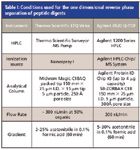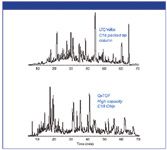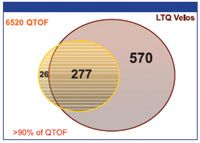Comparison of Ion Trap and Q-TOF Mass Spectrometers for Protein Identifi cation
This study uses the challenging analysis of a complex, multi-organ peptide digest of Caenorhabditis elegans (C. elegans) to compare the performance of a novel linear ion trap mass spectrometer and a quadrupole time-of-flight (Q-TOF) mass spectrometer.
This study uses the challenging analysis of a complex, multi-organ peptide digest of Caenorhabditis elegans (C. elegans) to compare the performance of a novel linear ion trap mass spectrometer and a quadrupole time-of-flight (Q-TOF) mass spectrometer.
Comprehensive definition of a proteome is a necessary foundation for subsequent investigations of proteome dynamics. Undiscovered components within a proteome frequently include dynamically modified forms which exist at abundance levels undetectable by most instrumentation. The development of more sophisticated instrumentation is essential for exhaustive characterization of complex proteomes.
Tandem mass spectrometry based on linear ion traps has become the technology of choice for peptide and protein identification. The preference for this instrumentation is attributable to robustness, ease of use, superior MS, and especially MS-MS performance.
Instrumentation
The instruments evaluated are the Thermo Scientific LTQ Velos ion trap mass spectrometer and the Agilent 6520 quadrupole time-of-flight (Q-TOF).
The LTQ Velos includes several novel technologies, including a stacked-ring ion guide (S-Lens) and a dual-pressure linear ion trap. The radio frequency S-lens significantly increases transmission of ions into the mass analyzer. This reduces the time required to inject the desired ion population into the linear ion trap.
Traditional single-pressure ion traps operate at a pressure, typically ~2 mTorr, that is a compromise between what is optimum for trapping and fragmentation and what is optimum for mass analysis scanning and resolution. In the dual-pressure linear ion trap, higher pressure (~5 mTorr) in the first cell improves trapping efficiency by ~50%. This translates directly to shorter cycle times and increased sensitivity. The higher pressure also improves the speed and efficiency of precursor isolation and fragmentation. This reduces cycle times and increases dynamic range for MS-MS analysis. The second cell operates at a lower-than-standard pressure (~0.4 mTorr). This allows for a faster mass analysis scan with increased resolution.
Predictive automatic gain control (AGC), a novel method for controlling the ion population in the trap, dramatically increases the practical scan rate achievable in a typical data-dependent tandem MS experiment. Predictive AGC eliminates pre-scans conducted prior to each tandem MS scan, instead predicting the injection time required based on ion flux and the relative intensity of parent ions measured in the preceding full MS scan.
Experimental
Sample Preparation and LC–MS-MS Analysis
The soluble fraction of mixed-stage C. elegans homogenates was enzymatically digested. The proteolytic digest was separated by reverse-phase chromatography for each LC–MS-MS run. Details of the chromatographic conditions are listed in Table I.

Figure 1: Base peak chromatograms from 60 min everse-phase separations of one microgram of an enzymatic digest of C. elegans.
Analyses were run on the LTQ Velos ion trap and on an Agilent 6520 Q-TOF mass spectrometer equipped with HPLC-Chip/MS separation/ionization. Data were searched against an NCBI database with the Mascot search engine through Proteome Discoverer 1.0 software. All data were filtered to a false discovery rate of 1%.
Results and Discussion
Figure 1 depicts the base peak chromatograms from 60-minute gradients.
Compared to the Q-TOF, the LTQ Velos dual-pressure linear ion trap identified significantly larger numbers of unique peptides and proteins from the proteolytic digest of C. elegans. The LTQ Velos ion trap identified 165.7%±3.1 more unique peptides than did the Q-TOF operated at ~3 Hz. As a result, the number of proteins identified by the LTQ Velos ion trap was 240%±8 more than the number of proteins identified by the Q-TOF.

Figure 2: Venn diagram illustrating the overlap in proteins identified between instruments for a 60 min reverse-phase separation of 1 microgram of C. elegans (data reported at 1% FDR).
A significant overlap existed in the sets of proteins identified between instruments, as illustrated in Figure 2. The LTQ Velos dual-pressure ion trap identified >90% of the proteins identified by the Q-TOF, plus an additional 570 proteins. Therefore, the Q-TOF identified a subset of the proteins identified by the LTQ Velos, rather than any significant augmentation to the complement of proteins. Within replicate runs on the LTQ Velos ion trap, overlap of the identified proteins was greater than 70%, and 85% of proteins were identified in two out of three runs on average, indicating high reproducibility.

Table I: Conditions used for the one dimensional reverse phase separation of peptide digests
The average Mascot score (1113.4) of the top 20 proteins identified by the LTQ Velos ion trap was 119% higher than the average Mascot score (506.7) of the top 20 proteins identified by the Q-TOF operated at a ~3 Hz scan rate. The lower quality of Q-TOF MS-MS scans appeared to contribute to a significantly lower number of peptides identified. Better mass accuracy in the Q-TOF MS and MS-MS scans did not compensate for lower quality MS-MS scans, i.e. those with fewer sequence ions than equivalent spectra obtained by the linear ion trap.
Increasing the scan rate on the Q-TOF to 6 Hz resulted in a decrease in the number of identified peptides, as the signal-to-noise ratio and quality of analytical scans decreases with increased scan rate on a beam type mass spectrometer.
Conclusions
The sensitive detection and identification of components within complex proteomics samples is crucial for the characterization and understanding of proteome dynamics. The technological advancements of the LTQ Velos dual-pressure linear ion trap mass spectrometer, including increased speed of acquisition and sensitivity, have resulted in significant improvement in the identification of peptides and proteins, including an increase in identification of lower-intensity precursors when compared to alternative technologies.
The higher quality of the MS-MS scans from the linear ion trap produced higher Mascot scores for equivalent peptides compared to those of the Q-TOF instrument. The higher mass accuracy of analytical scans acquired with the Q-TOF was not sufficient to produce equivalent peptide identification. Increasing the scan rate on the Q-TOF resulted in a decrease in signal and spectral quality for MS and MS-MS scans and a corresponding decrease in the number of identified peptides.

Thermo Fisher Scientific
355 River Oaks Parkway, San Jose, CA 95134
tel. (800)532-4752; fax (561)688-8731
Website: www.thermo.com/ms

SEC-MALS of Antibody Therapeutics—A Robust Method for In-Depth Sample Characterization
June 1st 2022Monoclonal antibodies (mAbs) are effective therapeutics for cancers, auto-immune diseases, viral infections, and other diseases. Recent developments in antibody therapeutics aim to add more specific binding regions (bi- and multi-specificity) to increase their effectiveness and/or to downsize the molecule to the specific binding regions (for example, scFv or Fab fragment) to achieve better penetration of the tissue. As the molecule gets more complex, the possible high and low molecular weight (H/LMW) impurities become more complex, too. In order to accurately analyze the various species, more advanced detection than ultraviolet (UV) is required to characterize a mAb sample.















